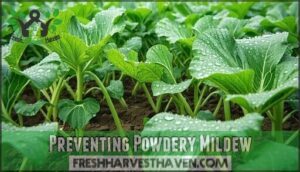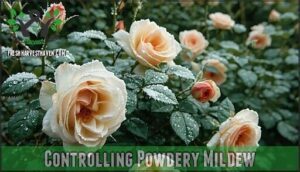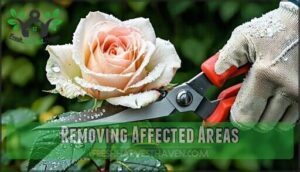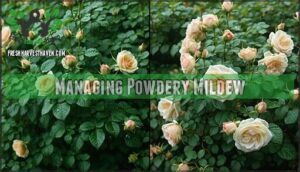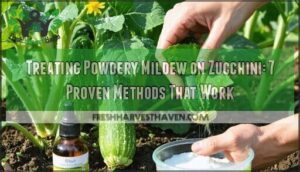This site is supported by our readers. We may earn a commission, at no cost to you, if you purchase through links.
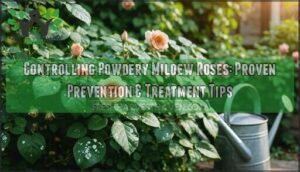 Controlling powdery mildew roses starts with prevention and quick action.
Controlling powdery mildew roses starts with prevention and quick action.
You’ll spot this fungal disease as white, powdery patches on leaves and stems.
Improve air circulation by spacing plants properly and pruning for airflow.
Water at soil level, not on leaves, since moisture feeds the fungus.
Apply preventive treatments like neem oil or baking soda spray every two weeks during growing season.
Choose resistant varieties when planting new roses.
If mildew appears, remove affected parts immediately and increase treatment frequency.
Combine cultural practices with organic fungicides for best results.
The key is staying ahead of the problem rather than chasing it, using smart timing and the right arsenal make all the difference, which is crucial for effective control.
Table Of Contents
- Key Takeaways
- What is Powdery Mildew
- Identifying Powdery Mildew
- Preventing Powdery Mildew
- Controlling Powdery Mildew
- Treating Powdery Mildew
- Managing Powdery Mildew
- Frequently Asked Questions (FAQs)
- How do I get rid of powdery mildew on my roses?
- What is the best method for controlling powdery mildew?
- Can you use Dawn dish soap for powdery mildew?
- What is the most effective fungicide to control powdery mildew?
- Can you treat powdery mildew on roses?
- What causes powdery mildew on roses?
- Do Roses get mildew?
- Does potassium bicarbonate kill powdery mildew on roses?
- How do you know if a Rose has powdery mildew?
- Are climbing roses prone to powdery mildew?
- Conclusion
Key Takeaways
- Start with prevention first – Plant roses in full sun with proper spacing (3-4 feet apart) and choose resistant varieties to create conditions where powdery mildew cannot thrive.
- Water smart to avoid feeding the fungus – Always water at soil level, never on leaves, since moisture on foliage encourages fungal growth and spore development.
- Act fast when you spot white powdery patches – Remove infected parts immediately with clean tools and increase treatment frequency to prevent the spread throughout your garden.
- Use a combination approach for best results – Apply preventive treatments like neem oil or baking soda spray every two weeks, rotating between different methods to avoid resistance buildup.
What is Powdery Mildew
Powdery mildew is a common fungal disease that creates a distinctive white, powdery coating on your rose leaves and stems.
You’ll recognize this unwelcome visitor by its telltale dusty appearance that can easily be wiped off with your finger, though doing so won’t solve the underlying problem, which is often associated with fungal diseases.
Powdery Mildew Symptoms
Early indicators of powdery mildew include a fine white powder coating your rose leaves, stems, and buds.
This fungal disease causes leaf discoloration—turning purple, red, or yellow—followed by curling and premature dropping.
Bud infections prevent flowers from opening properly, while growth deformity affects new shoots.
Mildew symptoms to watch for:
- White powdery spots on both leaf surfaces that wipe off easily
- Mildew progression from small black spots to widespread white coating
- Severely reduced photosynthesis (up to 50% in heavy infections)
- Leaves becoming crinkled, yellowed, and eventually falling off
Powdery Mildew Causes
Understanding what triggers powdery mildew helps you protect your roses from this persistent fungal species. The culprit behind those chalky white patches isn’t just bad luck—it’s a perfect storm of conditions.
Powdery mildew isn’t random—it’s nature’s perfect storm waiting to strike your roses.
Spore dispersal happens when environmental factors align just right. Fungal spores spread through wind and splashing water, finding vulnerable plants during warm days followed by cool, humid conditions. Poor air circulation creates stagnant pockets where moisture lingers.
Overwintering habits make this fungus particularly sneaky. It survives dormant in buds and plant debris, waiting for favorable weather. Humidity influence becomes critical—the fungus thrives at 60-80°F with high humidity but low leaf wetness.
One preventative measure is to select mildew resistant varieties when planting.
Key mildew causes include:
- Warm days followed by cool, humid nights
- Poor air circulation around plants
- Shaded garden areas with limited sunlight
- Stressed or weakened rose bushes
Powdery Mildew Lifecycle
Looking at the powdery mildew lifecycle, fungal growth starts when mildew spores land on rose surfaces during favorable conditions.
Spore germination occurs rapidly in warm, humid environments between 60-80°F.
The fungus reproduces through asexual reproduction, creating countless new spores that spread via wind.
During overwintering stages, the pathogen survives in dormant buds and plant tissue.
This continuous mildew life cycle enables rapid disease spread throughout your garden, with each generation potentially infecting new plants within 7-10 days under ideal conditions.
Identifying Powdery Mildew
Proper identification of powdery mildew saves your roses from severe damage and prevents costly treatment mistakes.
You’ll need to examine specific visual symptoms and understand the environmental factors that create perfect conditions for this fungal disease to take hold.
Confirming Presence of Mildew
Spotting powdery mildew requires sharp visual inspection to catch early signs before they spread. The white powder coating rose leaves looks like flour dusting, easily rubbed off with your finger.
Severity assessment helps determine your next move:
- Microscopic analysis reveals spore clusters on leaf undersides
- Environmental clues like humidity and poor airflow indicate favorable conditions
- Fungal growth appears as circular patches spreading outward
Quick identification prevents mildew symptoms from overtaking your entire garden.
Environmental Conditions Favoring Mildew
The perfect storm for powdery mildew strikes when humidity levels climb above 60% while air circulation stagnates.
Temperature ranges between 60-80°F create ideal breeding conditions, especially in shaded areas with poor sunlight exposure.
Environmental conditions worsen when soil moisture combines with humid climates and limited airflow around your roses.
Proper spacing helps boost air circulation.
Weakened Plant Health and Susceptibility
Weakened roses become sitting ducks for powdery mildew attacks. Plant stress from poor care creates perfect conditions for fungal infections roses can’t fight off.
Stressed roses can’t defend themselves—they’re basically sending out dinner invitations to powdery mildew.
Your roses’ vulnerability increases when they’re struggling with basic needs:
- Nutrient deficiency leaves plants defenseless against mildew on roses
- Poor water management stresses root systems and overall immunity
- Root damage from overwatering or compacted soil quality weakens defenses
- Insufficient sunlight reduces natural disease resistance
- Overcrowded plantings create humid microclimates that encourage infection
Healthy roses naturally resist rose disease control issues, while stressed plants practically invite weakened plant health problems through compromised immune systems.
Preventing Powdery Mildew
Prevention starts with smart planting choices and proper garden management.
You’ll save yourself hours of treatment time by creating conditions that make powdery mildew less likely to develop in the first place.
Planting in Full Sun and Well-Draining Soil
Your roses need sun exposure and proper soil drainage to beat powdery mildew. Plant them where they’ll get at least 6 hours of direct sunlight daily. Full sun keeps leaves dry and creates hostile conditions for fungal spores.
Focus on soil quality when planning your garden layout. Well-draining soil prevents water from pooling around roots, reducing humidity that encourages rose disease prevention. Choose your rose selection carefully, considering each variety’s drainage systems needs for maximum powdery mildew resistance.
Avoiding Overcrowding and Overfertilizing
Give your roses breathing room to prevent powdery mildew’s attack. Overcrowding creates humid pockets where spores thrive, while overfertilizing weakens plants’ natural defenses.
Essential spacing strategies:
- Proper Spacing: Plant roses 3-4 feet apart for maximal Air Circulation
- Soil Quality: Test before adding fertilizer to avoid Overfertilizing stressed plants
- Pruning Techniques: Remove dense growth and clear garden debris regularly
Smart Fertilizer Control keeps roses strong without making them vulnerable to disease. Maintaining healthy plants requires understanding powdery mildew prevention techniques to guarantee maximal growth.
Using Natural Fungicides and Resistant Varieties
You’ll strengthen your defense against powdery mildew by combining natural fungicides with resistant rose varieties.
Neem oil at 2% concentration provides excellent protection, while milk treatment using equal parts milk and water achieves 77% efficiency in greenhouse studies.
Baking soda solutions offer another organic spray option for natural mildew control.
Choose mildew resistant roses like ‘Knock Out’ or dwarf varieties that naturally resist infection.
Potassium bicarbonate applied as a 0.5% solution works as both preventive and treatment.
These organic rose care methods reduce chemical dependency while maintaining rose fungus treatment effectiveness.
Effective powdery mildew control requires a thorough approach to prevent the spread of the disease.
Regular Monitoring and Inspection
The secret to preventing powdery mildew lies in early detection through consistent plant observation.
Daily checks transform you from reactive gardener to proactive protector, spotting trouble before it spreads.
- Early warning signs: White powdery patches appearing on leaf surfaces within 3-5 days of initial infection
- Fungal detection clues: New growth deformation and discolored buds that fail to open properly
Rose inspection becomes second nature when you understand mildew identification markers.
Regular monitoring catches mildew symptoms before they compromise your roses’ health completely.
Controlling Powdery Mildew
When powdery mildew strikes your roses, you’ll need a multi-pronged approach to regain control and protect your garden.
The key is combining immediate treatment with ongoing management strategies to stop the spread and prevent future outbreaks, which involves ongoing management strategies.
Organic Treatment Options
When prevention fails, organic treatments provide safe, effective powdery mildew treatment options.
Neem oil disrupts fungal growth while protecting beneficial insects—apply bi-weekly for best results. Milk solution at a 1:9 ratio introduces helpful bacteria that attack mildew fungi. Baking soda mixed with soap (1 tablespoon per gallon) creates alkaline conditions fungi can’t tolerate. Potassium bicarbonate proves even more effective against established infections.
These organic treatments combined with proper cultural practices like improved air circulation offer powerful, eco-friendly protection for your roses.
To maintain healthy plants, consider watering early each day to allow leaves to dry before nightfall.
Chemical Treatment Options
When facing stubborn powdery mildew, chemical treatments deliver reliable results where organic methods fall short.
- Systemic fungicides like myclobutanil penetrate plant tissues for thorough protection
- Contact sprays provide immediate surface treatment against active infections
- Application timing proves vital—treat at first symptom appearance for maximum effectiveness
- Resistance management requires rotating between different fungicide classes regularly
- Chemical alternatives include sulfur-based fungicides and copper fungicide formulations for varied approaches
Tebuconazole and trifloxystrobin achieve over 85% disease control in trials.
Some gardeners may prefer to use a systemic rose treatment.
These chemical treatments work best when applied every 7-10 days during high-risk conditions, ensuring full plant coverage including leaf undersides.
Cultural Controls and Pruning
Smart pruning techniques transform your rose defense system.
Remove infected stems with clean, sharp tools to boost airflow improvement around remaining branches.
Plant thinning creates breathing room that sunlight loves and fungus hates.
Cut diseased growth back to healthy tissue, making strategic cuts that promote disease control through better air circulation and reduced moisture retention.
Natural Fungicides and Home Remedies
Mother Nature offers powerful allies against rose powdery mildew.
Neem oil disrupts fungal cell membranes while milk treatment (1:9 ratio with water) promotes beneficial microbes that suppress mildew.
Baking soda solutions alter leaf pH, creating hostile conditions for fungi. Potassium bicarbonate raises surface pH effectively.
These natural remedies require weekly applications but deliver impressive results. Rotate between homemade sprays to prevent resistance while keeping your roses healthy and vibrant.
Treating Powdery Mildew
When powdery mildew strikes your roses, quick action prevents the infection from spreading to healthy parts of the plant.
You’ll need to combine physical removal with targeted treatments to eliminate the fungus and restore your roses’ health.
Removing Affected Areas
Tackle rose powdery mildew with strategic removal before it spreads throughout your garden.
Start by evaluating the severity of infection on each affected plant:
- Cutting Techniques: Use clean, sharp pruning shears to remove infected leaves, stems, and buds completely
- Tool Sterilization: Disinfect pruning tools with rubbing alcohol between cuts to prevent cross-contamination
- Disposal Methods: Seal all infected plant material in plastic bags for trash disposal—never compost
- Timing Matters: Remove affected areas during dry weather conditions to minimize spore dispersal
This targeted pruning approach stops mildew control problems before they overwhelm your roses.
You can also use organic milk sprays to help control the spread.
Using Fungicides and Homemade Remedies
Once you’ve removed infected parts, deploy proven fungicides and homemade remedies to eliminate rose powdery mildew.
These treatments target mildew at its source:
- Neem oil – Natural fungicide with proven homemade efficacy
- Milk spray – Mix equal parts milk and water for gentle treatment
- Baking soda solution – One tablespoon per gallon creates alkaline environment
- Sulfur powder – Traditional fungicide application for severe infections
- Potassium bicarbonate – Professional-grade mildew control without harsh chemicals
Apply treatments weekly during cool morning hours for ideal remedy timing and resistance management.
Combining Treatments for Best Results
Your best results come from layering different mildew treatment approaches together.
Start with synergistic fungicides like neem oil paired with baking soda solutions. Practice rotating treatments weekly to prevent resistance buildup.
This integrated approach combines holistic rosecare with strategic treatment timing for maximum disease management effectiveness.
Managing Powdery Mildew
Once you’ve treated the initial powdery mildew outbreak, managing it becomes a long-term commitment to prevent future problems.
Success depends on creating conditions that discourage the fungus while keeping your roses healthy and strong.
Maintaining Good Air Circulation
Good airflow acts like a natural shield against powdery mildew, keeping your roses healthy and vibrant. Pruning techniques and plant spacing create the ventilation roses need to thrive.
- Space roses 3-4 feet apart for ideal airflow benefits
- Remove dense inner branches through strategic pruning
- Position plants where gentle wind exposure occurs naturally
- Use trellising roses methods that promote air movement
Proper ventilation reduces humidity around foliage, making it harder for spores to establish. Employing resistant plant varieties can also help prevent infection. These preventive measures transform your garden into an inhospitable environment for mildew while promoting robust rose health.
Promoting Healthy Plant Growth
Strong plant vigor starts with proper watering at the base, not overhead spraying.
Balanced fertilization feeds roses without encouraging soft growth that attracts rose powdery mildew.
Sunlight exposure of six hours daily strengthens natural defenses.
Soil health with good drainage prevents root stress.
Robust plant nutrition creates resilient roses that resist disease naturally through superior plant health.
Choosing Resistant Rose Varieties
Smart cultivar selection forms your strongest defense against powdery mildew.
Choose disease-resistant roses like Knock Out varieties, which show 90% lower mildew incidence than susceptible types.
These resistant varieties feature genetic breeding for resistance and thicker leaf cuticles that block fungal penetration.
- Long-term resistance strategies: Regional variety performance matters – select mildew-resistant roses suited to your specific climate conditions for sustained protection.
Ensuring Good Garden Hygiene
When you maintain proper garden hygiene, you’re building a fortress against powdery mildew.
Tool sanitation between cuts prevents disease spread—disinfect pruning shears with rubbing alcohol. Remove plant debris immediately; infected leaves harbor fungal spores through winter.
Practice strategic mulch management by applying fresh layers in spring to cover soil-borne spores. Weed control improves airflow and eliminates competing hosts.
Never add diseased material to compost. Focus on soil health through proper drainage and debris removal.
These plant sanitation practices transform garden maintenance from reactive to proactive disease prevention.
Frequently Asked Questions (FAQs)
How do I get rid of powdery mildew on my roses?
Don’t think powdery mildew’s unbeatable—it’s not! Remove affected leaves, spray with neem oil or baking soda solution, improve air circulation, and water at soil level to prevent recurrence effectively.
What is the best method for controlling powdery mildew?
Remove affected plant parts first, then apply neem oil or potassium bicarbonate spray. Improve air circulation through pruning and make certain full sunlight exposure for your roses.
Can you use Dawn dish soap for powdery mildew?
Yes, you can use Dawn dish soap for powdery mildew.
Mix a few drops with baking soda or potassium bicarbonate solution to help it stick better to leaves and improve treatment effectiveness.
What is the most effective fungicide to control powdery mildew?
Neem oil, sulfur-based fungicides, and myclobutanil are your most effective options. For organic control, potassium bicarbonate works well. Apply every 7-14 days following label instructions for best results.
Can you treat powdery mildew on roses?
Yes, you can treat powdery mildew on roses effectively.
Start by removing infected parts, then apply fungicides like neem oil, sulfur, or baking soda solutions.
Improve air circulation and avoid overhead watering for prevention.
What causes powdery mildew on roses?
While many think powdery mildew only strikes in wet weather, it actually thrives in dry, humid conditions.
The fungus spreads through airborne spores, particularly after warm days followed by cool, humid nights.
Do Roses get mildew?
Roses absolutely get powdery mildew.
This common fungal disease creates white, powdery spots on leaves and stems.
You’ll notice it most during warm days followed by cool, humid nights when conditions are just right for fungal growth.
Does potassium bicarbonate kill powdery mildew on roses?
Potassium bicarbonate effectively kills powdery mildew on roses by disrupting the fungal cell walls.
It’s both a preventative treatment and active remedy for existing infections.
Mix one tablespoon per gallon of water and spray affected areas, using it as an active remedy for existing infections.
How do you know if a Rose has powdery mildew?
Up to 50% photosynthesis reduction occurs with severe infections.
You’ll spot fine white powder on leaves, stems, and buds that wipes off easily.
Look for curling, yellowing leaves and deformed new growth.
Are climbing roses prone to powdery mildew?
Yes, climbing roses are prone to powdery mildew, especially in humid conditions with poor air circulation.
Their dense growth and vertical structure can trap moisture, creating ideal conditions for fungal development.
Conclusion
Like a gardener’s watchful eye preventing weeds from taking root, controlling powdery mildew roses requires consistent vigilance and proactive care.
Success comes from combining prevention strategies with swift treatment responses. Space your roses properly, water at soil level, and apply preventive treatments regularly.
Choose resistant varieties and maintain good garden hygiene. When mildew appears, act quickly with organic or chemical treatments while removing affected areas.
Remember, controlling powdery mildew roses becomes manageable when you stay ahead of the problem rather than reacting to it, by using proactive care and consistent vigilance.
- https://en.wikipedia.org/wiki/Rosa_%27William_Baffin%27
- https://ipm.ucanr.edu/agriculture/floriculture-and-ornamental-nurseries/powdery-mildew/
- https://www.sciencedirect.com/science/article/abs/pii/S0261219499000460
- https://www.extension.purdue.edu/extmedia/bp/bp-5-w.pdf
- https://www.agronomyjournals.com/article/view/1290/S-7-8-2




